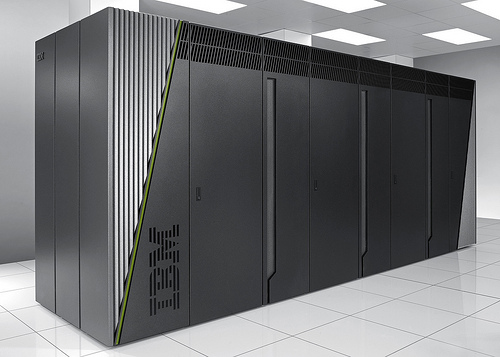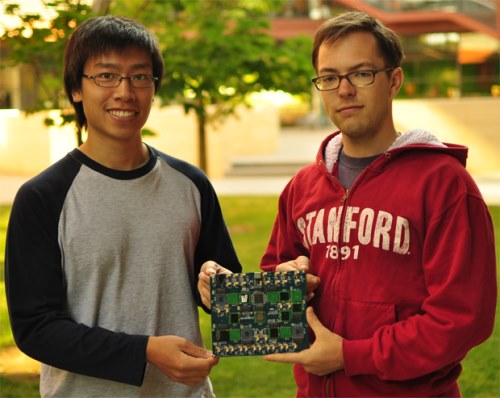Supercomputers
Last November, IBM revealed that its lightning speed, Blue Gene/Q Sequoia supercomputer achieved a record simulation of more than 530 billion neurons. The Blue Gene/ Q Sequoia can perform over 16 quadrillion calculations per second, ranking as the second-fastest supercomputer in the world. (The number one spot is held by Cray’s Titan, built by the Oak Ridge Laboratory in Tennessee.)

The Blue Gene/Q Sequoia. (Image via IBM)
So the question arises…
Is the human brain, in fact, smarter than a supercomputer with these capabilities? Kwabena Boahen, Ph.D. professor at Stanford University and director of the Brains in Silicon Research Laboratory says it is.
“The brain is actually able to do more calculations per second than even the fastest supercomputer,” said Boahen.
Of course, the brain makes a single calculation much slower than a supercomputer, but the brain can actually execute more calculations per second because it is “massively parallel.” What this means is that networks of neurons actually work together to simultaneously solve many problems at once. However, in computing platforms, each step must be completed before the next step begins.
Creating the brain simulator
Boahen and researchers at his laboratory have worked to create a replica of the brain’s computing abilities using original hardware and software applications. So far what they’ve developed is a computing platform that mimics the activity of one million neurons. (Not quite the amount that are in the human brain.)

Two graduate students from Stanford University worked with Boahen to develop the Neurogrid. (Image credit: Samir Menon/ Stanford University)
What separates their platform, which they’ve named “Neurogrid,” from a supercomputer, is that it’s the first simulation platform that can model one million neurons in real time, and therefore offers researchers a compelling tool for studying the human brain.
Neurogrid contains 16 chips, each containing over 65,000 silicon “neurons.” The neurons’ activity can be programmed according to about 80 factors, which grants researchers the ability to mimic the unique characteristics of different kinds of neurons. The soft-wired “synapses” intersect across the board and shut signals between the simulated neurons and the thousands of neurons they are connected with. This set up creates an accurate representation of what kind of communication actually takes place in the brain.
Why is the Neurogrid more effective than a supercomputer?
So far, findings show that the Blue Gene/ Q Sequoia supercomputer’s simulation took 1,500 times longer than it would take the brain to do the same activity. Even more affordable brain simulators that use computing powers such as central and graphical processing units are slower than the brain.
“Neurogrid doesn't take an hour to simulate a second of brain activity. It takes a second to simulate a second of brain activity,” said Boahen.
The Neurogrid is also more energy efficient than a supercomputer, using a fraction of the energy. The Blue Gene/ Q Sequoia uses 8 megawatts of electricity (that’s enough to power 160,000 homes) while the Neurogrid uses just 5 watts (enough to power just one cellphone charger).
Future impact
Neurogrid will not only be able to help researchers discover more about the inner workings of the brain, but also has the potential to reveal more about diseases such as autism and schizophrenia. Neurogrid can also be used to create new systems for advancements in neural prosthetics and robotic controllers.
Story via The National Science Foundation.
Advertisement
Learn more about Electronic Products Magazine





